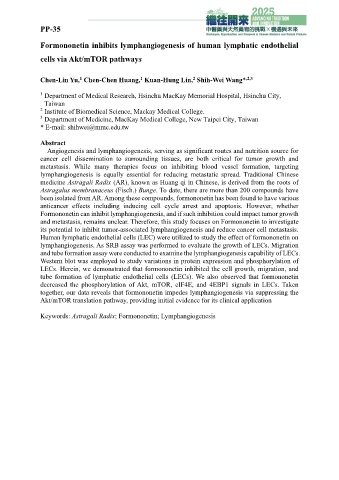Page 217 - 2025中醫藥與天然藥物聯合學術研討會-中醫藥與天然藥物的挑戰X機遇與未來大會手冊
P. 217
PP-35
Formononetin inhibits lymphangiogenesis of human lymphatic endothelial
cells via Akt/mTOR pathways
1
2
Chen-Lin Yu, Chen-Chen Huang, Kuan-Hung Lin, Shih-Wei Wang* ,2,3
1
1 Department of Medical Research, Hsinchu MacKay Memorial Hospital, Hsinchu City,
Taiwan
2 Institute of Biomedical Science, Mackay Medical College.
3 Department of Medicine, MacKay Medical College, New Taipei City, Taiwan
* E-mail: shihwei@mmc.edu.tw
Abstract
Angiogenesis and lymphangiogenesis, serving as significant routes and nutrition source for
cancer cell dissemination to surrounding tissues, are both critical for tumor growth and
metastasis. While many therapies focus on inhibiting blood vessel formation, targeting
lymphangiogenesis is equally essential for reducing metastatic spread. Traditional Chinese
medicine Astragali Radix (AR), known as Huang qi in Chinese, is derived from the roots of
Astragalus membranaceus (Fisch.) Bunge. To date, there are more than 200 compounds have
been isolated from AR. Among these compounds, formononetin has been found to have various
anticancer effects including inducing cell cycle arrest and apoptosis. However, whether
Formononetin can inhibit lymphangiogenesis, and if such inhibition could impact tumor growth
and metastasis, remains unclear. Therefore, this study focuses on Formononetin to investigate
its potential to inhibit tumor-associated lymphangiogenesis and reduce cancer cell metastasis.
Human lymphatic endothelial cells (LEC) were utilized to study the effect of formononetin on
lymphangiogenesis. As SRB assay was performed to evaluate the growth of LECs. Migration
and tube formation assay were conducted to examine the lymphangiogenesis capability of LECs.
Western blot was employed to study variations in protein expression and phosphorylation of
LECs. Herein, we demonstrated that formononetin inhibited the cell growth, migration, and
tube formation of lymphatic endothelial cells (LECs). We also observed that formononetin
decreased the phosphorylation of Akt, mTOR, eIF4E, and 4EBP1 signals in LECs. Taken
together, our data reveals that formononetin impedes lymphangiogenesis via suppressing the
Akt/mTOR translation pathway, providing initial evidence for its clinical application
Keywords: Astragali Radix; Formononetin; Lymphangiogenesis

